Yellow squash is one of the popular homegrown vegetables in grocery stores and farmers markets. It’s also versatile, which means you can steam, bake, roast, saute, and puree this vegetable.
There are distinct types of squashes. Our guide lists nineteen kinds of yellow squash you can commonly find.
Table of Contents
19 Types of Yellow Squash
1. Butternut Squash
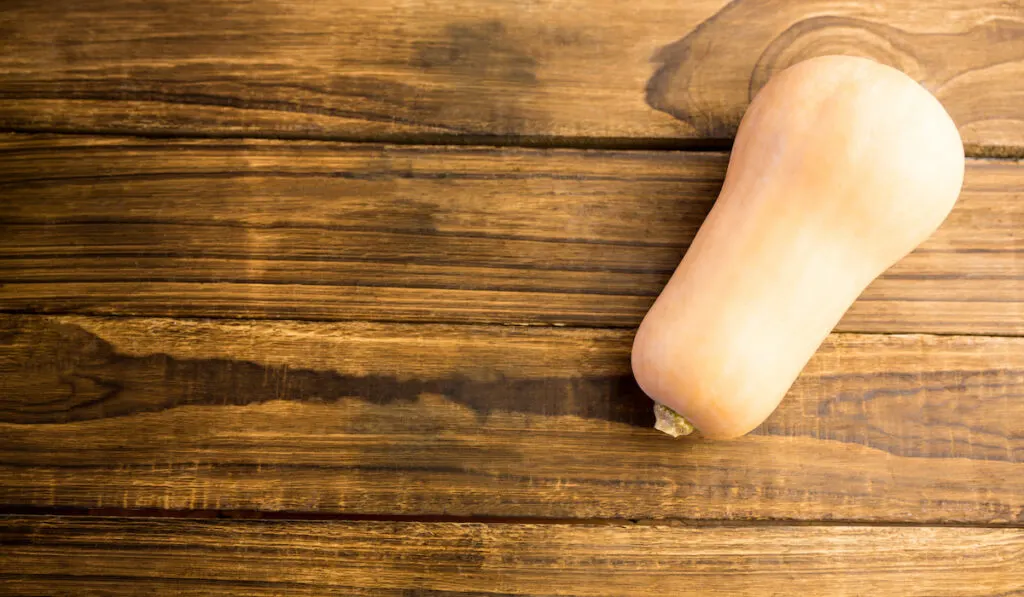
Butternut squash is a winter squash variety with peach-colored skin and rich orange, dense flesh. It’s available in varied sizes and shapes.
Butternut squash can be roasted, boiled, sauteed, or pureed and added to soups like pumpkin.
Butternut squash grows in any climate and is ready to harvest in 3-4 months. Furthermore, you can store the fruit for several months in a dark place.
When shopping for butternuts, look for one with an evenly colored, hard rind without gashes.
2. Spaghetti Squash
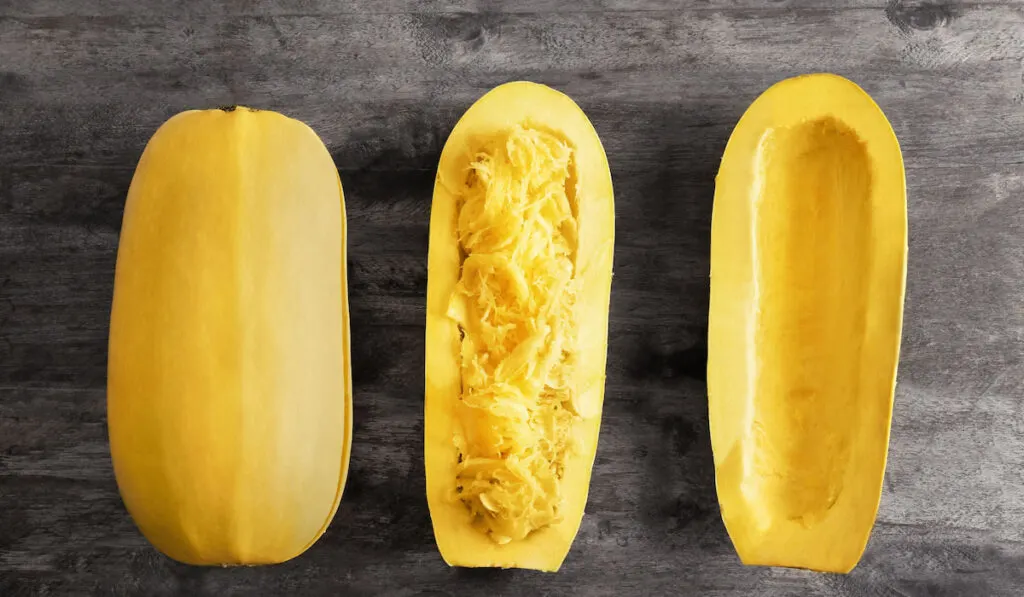
Spaghetti squash gets its name from its flesh, which looks like spaghetti noodles.
Its orange flesh forms strands that must be scraped out with a fork. Apart from its strands, the squash has a pale-yellow exterior and an oval shape like butternut.
Spaghetti squash is a low-carb pasta substitute.
Spaghetti squash adds a mild flavor to soups and sauces. You can also roast it and add it as a side.
3. Honeynut Squash

Honeynut squash looks like small butternut squash. It’s a cross between buttercup and butternut squash.
A honeynut squash is 3 to 5 inches long and has yellow skin and deep orange flesh.
A honeynut squash’s nutty and sweet flesh is similar to that of a butternut squash. You can roast, stuff, or use honeynut squash in pies or soups.
4. ‘Sweet Dumpling’ Squash
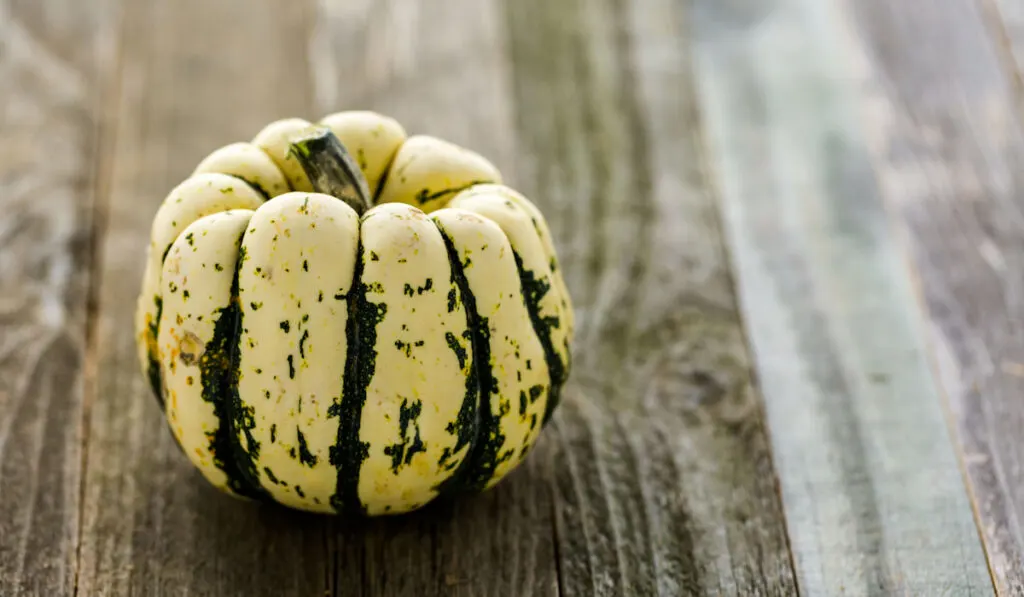
‘Sweet Dumpling’ squash has a creamy yellow skin with green stripes.
This winter squash weighs about one pound. It’s also one of the sweetest squash varieties and is a great addition to soups.
You can also roast it for that nutty flavor. Sweet dumpling squash is also great for baking.
5. Banana Squash

Banana squash has yellowish skin and can grow up to 4 feet long.
Banana squash has a similar taste to sweet potatoes and butternut squash. It contains dietary fiber, potassium, vitamins B6 and C, and potassium.
You’ll find it next to butternut in most grocery stores throughout fall and winter. Most grocery stores stock it in cut pieces as its size is difficult to transport.
You can bake, roast, or add banana squash to your pasta dishes, stews, and soups.
6. Yellow Squash

Yellow squash has dull to bright yellow skin, and its size is similar to a zucchini.
Yellow squash is often substituted for zucchini as its skin is soft and edible. You can use yellow squash in stir-fries.
Yellow squash can also act as a lasagna noodle substitute.
While a few yellow squash varieties can be eaten fresh, others are ideal for preservation or cooking.
7. Yellow Hubbard Squash
Yellow Hubbard squash is a large winter squash with a pumpkin and sweet potato taste.
Its yellow outer skin and flavor are similar to most winter squashes.
Hubbard squash is rich in iron and riboflavin.
Expect a sweet flavor and a grainy texture from the Yellow Hubbard squash. That makes it great for soups and purees. You can also roast, bake, or puree the squash.
8. Gold Acorn Squash

Gold acorn squash is a favorite winter squash rich in vitamin A. Although it’s a new variety of acorn squash, it is just as good with a nutty, sweet flavor.
Its yellow skin is firm and smooth. It can be left to mature and harvested as winter squash or young like summer squashes.
Acorn squash can be baked, roasted, grilled, steamed, or sauteed. It can also be used for stuffing in its immature stage.
Gold acorn squash can also be added to cakes, pasta, curries, and risotto.
9. Gold Rush Squash

Gold rush squash has a similar shape to a zucchini. Its golden yellow color is distinct, and the squash grows up to 8 inches long.
The squash is often used for stuffing due to its unique skin. You can add it to your stir-fries, baked goods, and salads.
10. ‘Golden Egg’ Squash
‘Golden Egg’ hybrid squash is another popular yellow squash known for its succulent flavor and delicate texture.
It has a spherical egg shape, like a zucchini.
You can use ‘Golden Egg’ squash as a zucchini substitute in your recipes.
The summer squash has a nutty but sweet flavor, making it perfect for stuffing.
Most gardeners prefer to pick them at 4 inches long as the squash is ready to harvest in 40 days.
11. Yellow Straightneck Squash
The yellow straightneck squash resembles a yellow crookneck squash in texture and flavor. The difference is its shape.
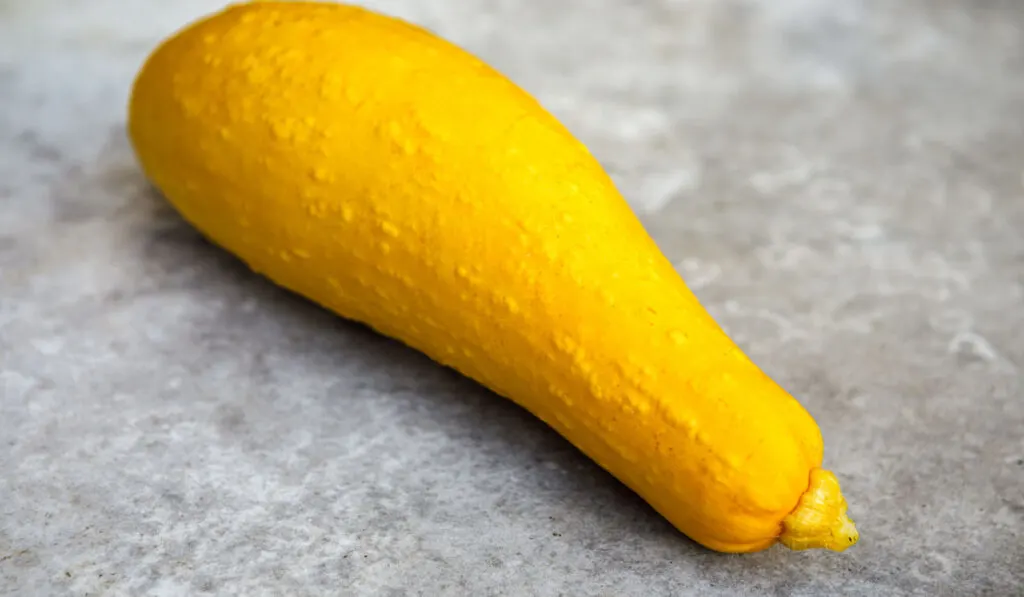
This summer squash has a straight shape like that of zucchini. Some people harvest it when it’s young to get delicious and tender flesh.
You can pair yellow straightneck squash in a salad to add that sweet flavor. It can also be used in stir-fries, soups, kabobs, and other dishes that call for a fleshy and mildly sweet vegetable.
12. Yellow Crookneck Squash
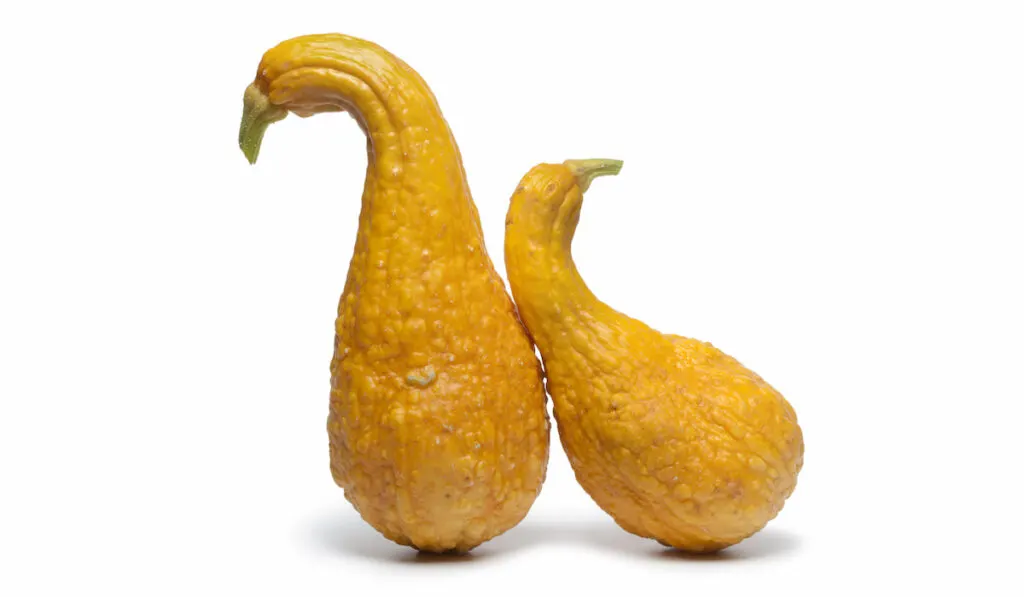
Crookneck squash is another type of yellow squash that is easy to grow. It has a curved neck, and its skin can be smooth or bumpy depending on the variant.
It’s also famous for its prolific harvest, as one plant can produce a lot of fruit, enough to feed a family for days. Crookneck squash produces fruit until it’s killed by disease or frost.
The yellow crookneck squash can be used in different pasta and soup recipes. It can also be grilled or roasted with spices and added as a side.
13. ‘Zephyr’ Squash
A ‘Zephyr’ squash looks like a zucchini that’s been stretched and painted yellow on the top and light green on the bottom. The unique coloring comes from the crookneck, acorn, and ‘Delicata’ squash this variety was bred from.
You can eat ‘Zephyr’ squash raw.
You can roast, bake, saute, or bake this squash. It’s tasty with fresh herbs and cheese.
14. ‘Golden Nugget’ Squash
A ‘Golden Nugget’ squash looks like a mini pumpkin with an orange-yellow rind. Not surprisingly, some people call them Oriental pumpkins.
Dr. Holland of North Dakota State University bred this squash be a sweet potato substitute that could handle colder climates. The starchy texture of ‘Golden Nugget’ suits soups, curries, casseroles, and chili.
15. Pattypan or Scallop Squash
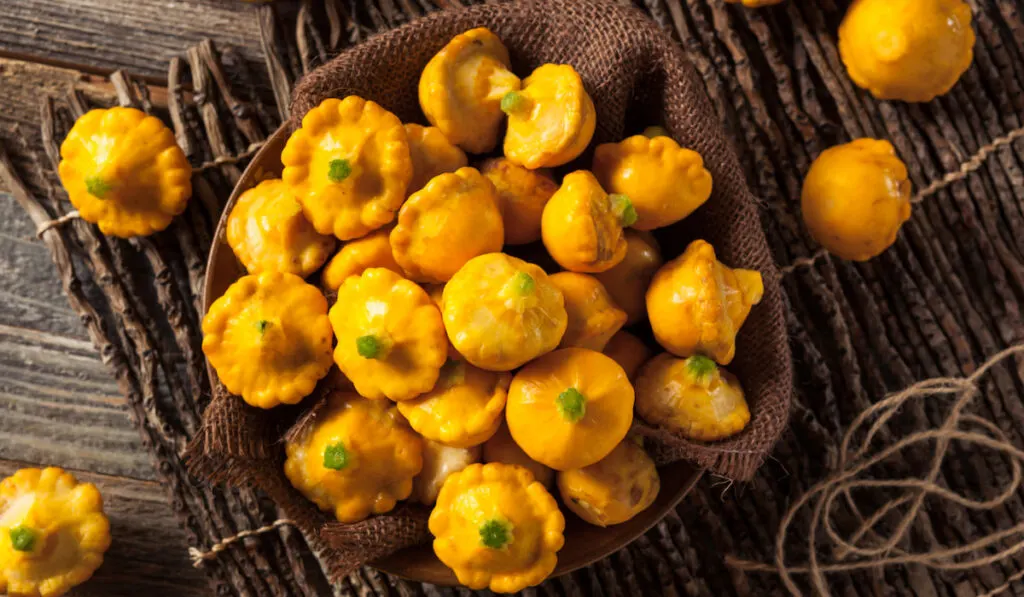
Pattypan squash is a summer squash also known as a flying saucer squash due to its shape.
The squash is easy to grow and produces a bumper harvest like zucchini.
Unlike most squashes, the pattypan squash is small, like a green pepper, but has tender skin that doesn’t need peeling.
Pattypan squash is best harvested when a couple of inches in size and cooked whole.
16. ‘Sunburst’
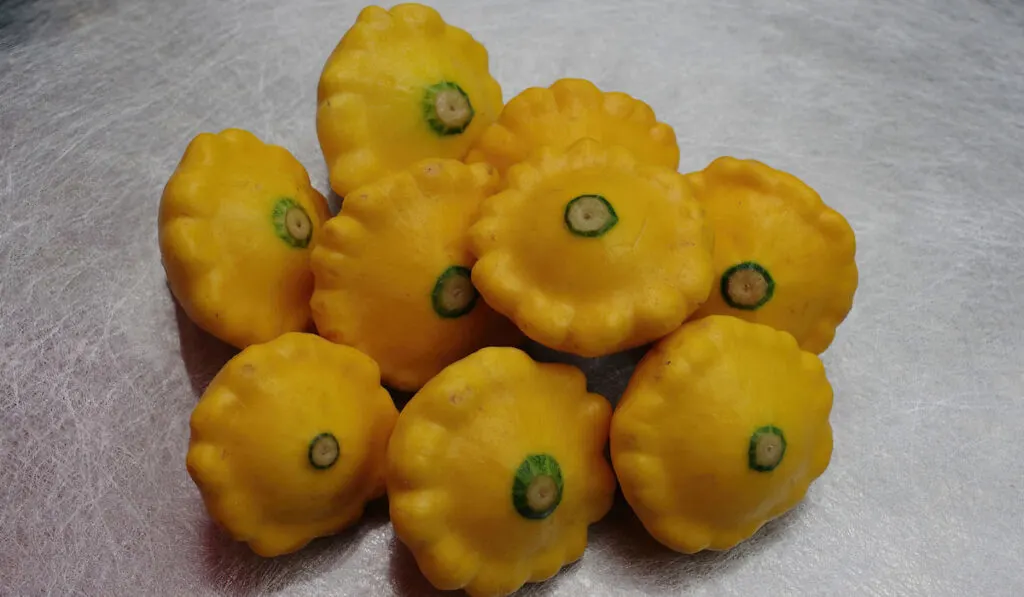
‘Sunburst’ is a pattypan hybrid with bright yellow color, and its ends have a dark green ring.
It has a rich buttery flavor and a soft texture. You’ll also love its fine-grained flesh when cooked.
Farmers prefer to pick ‘Sunburst’ at 3 inches wide for the best flavor. At that size, you don’t have to chop this squash before cooking it.
Additionally, the squash is ready to harvest in 55 days.
17. ‘Rheinau Gold’
‘Rheinau Gold’ is originally from Switzerland.
It has golden yellow skin and resembles a zucchini.
The open-pollinated variety doesn’t grow as significantly as other varieties and is ready to harvest within 50 days.
18. ‘Fortune’ Squash
‘Fortune’ squash is another yellow squash variety. It has pale yellow skin and is small compared to the yellow squash.
It’s also harvested earlier for that sweet flavor.
‘Fortune’ squash can be roasted, baked, or pureed to be added to soups.
19. Papaya Squash
Papaya squash looks like papaya. It has bright yellow skin and greenish freckles. Its bottleneck shape is unique.
Papaya squash has a delicate, mildly sweet flavor.
It’s best to bake papaya squash for a short period to avoid overcooking them.
Final Thoughts
Yellow squash is one of the easy-to-grow vegetables that can grow in all USDA plant hardiness zones. You can find both summer and winter squashes in our list above.
Hopefully, you now know the most common types of yellow squash on the market and how to incorporate them into your recipes.
Resources
- https://web.extension.illinois.edu/veggies/ssquash.cfm
- https://www.epicgardening.com/summer-squash/
- https://www.gardeningknowhow.com/edible/vegetables/squash/different-summer-squashes-to-grow.htm
- https://gardenerspath.com/plants/vegetables/best-summer-squash-varieties/
- https://ucanr.edu/sites/gardenweb/files/117472.pdf
- https://parade.com/1341331/bethlipton/types-of-squash/
- https://www.liveeatlearn.com/types-of-squash/
- https://all-americaselections.org/product/squash-papaya-pear/
- https://cleangreensimple.com/web-stories/different-types-of-squash-story/
- https://natureandnurtureseeds.com/products/rheinau-gold-zucchini
- https://foodiegardener.com/grow-gourmet-summer-squash-from-seed/summer-squash-golden-egg-hybrid/
- https://specialtyproduce.com/produce/Hubbard_Squash_9981.php
- https://www.gardeningknowhow.com/edible/vegetables/squash/sweet-dumpling-acorn-squash.htm
- https://specialtyproduce.com/produce/Banana_Squash_4587.php
- https://www.specialtyproduce.com/produce/Gold_Acorn_Squash_4141.php
- https://www.specialtyproduce.com/produce/Zephyr_Squash_7780.php
- https://specialtyproduce.com/produce/Golden_Nugget_Squash_298.php
- https://www.thedailymeal.com/indigenous-crop-golden-nugget-squash
